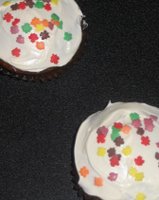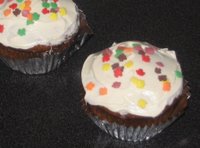This past week I had the pleasure of going through one of the first copies of Hannah Kaminsky's new cookbook My Sweet Vegan and it really is impressive. I knew there would be great recipes in it but what surprised me was how complete of a cookbook it is. This book not only had a large number of different recipes but it is a good information source for cooking vegan (and allergy-free, gluten-free, etc.), especially for someone new to vegan cooking such as myself.
My Sweet Vegan starts with a brief introduction into Hannah's journey into vegan baking and then an overview of some of the special ingredients and tools she uses. I found the ingredient guide helpful because some of the recipes called for ingredients I'd never used or purchased before. It also helped me look at the ingredients from a vegan's perspective. Case in point, margarine. I thought margarine was non-dairy. Not true, brands like Imperial and Land O Lakes contain whey and buttermilk respectively. I only looked based on Hannah's advice.
My Sweet Vegan is broken into five chapters: Sweet Starts, Cookies and Bars, Cakes and Cupcakes, Pies and Tarts, and Miscellaneous Morsals and Desserts. The majority of recipes fall into the Cookies and Bars and Cakes and Cupcakes chapters. Each recipe has a little caption where Hannah talks about the item in the recipe and a large, full-color photo. As far as cookbooks go, I'm more likely to pick a new recipe if there is a picture because either the picture will appeal to me or the picture gives me an idea of how the recipe should turn out. I was also impressed by the large variety of recipes. Some books give you a chapter on something like pies and then give you basically the same pie with different fillings. The recipes presented by My Sweet Vegan varied quite a bit. Old standards like banana nut muffins, black & white cookies, Whoopie pies, and pumpkin pecan pie share the pages with pink lemonade tartlets, root beer float cupcakes, graham flour fig scones, and green tea tiramisu.
My Sweet Vegan ends with a food allergy index and an ingredient index. The food allergy index is a brilliant idea, making it very easy choose a recipe for my food allergy challenged friends without having to go through the ingredients list of each recipe.
The first recipe I tried was the Cashew Creme Pear Tart, which I selected mainly because of the picture. I was able to find almost all of the ingredients in my local supermarket, which isn't very fancy and definitely not the source for hard to find items. The only thing I couldn't find there was the brown rice syrup, hence the use of corn syrup as a substitute. I also made 6 (should have been 7) small tarts out of this recipe instead of one big one. As you can see below, the instructions were straightforward and simple to follow and this tart was a breeze to make, especially if you use the cashew butter like I did. I really like how the pear and the cashew creme tasted together and the crust was very similar to a sugar cookie. This definitely would be a good sweet ending to any meal.
Overall, I really like My Sweet Vegan and even though I'm not vegan, I can see making recipes out of this book for a long time to come.
















 Lebkuchen
Lebkuchen









